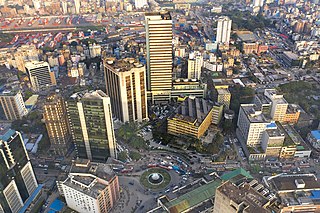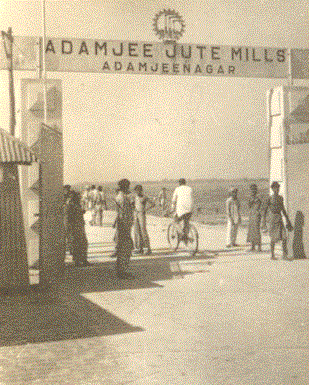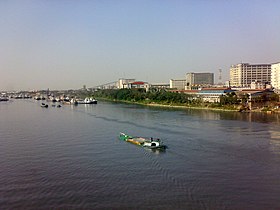
The economy of Bangladesh is a major developing market economy. As the second-largest economy in South Asia, Bangladesh's economy is the 37th largest in the world in nominal terms, and 25th largest by purchasing power parity. Bangladesh is seen by various financial institutions as one of the Next Eleven. It has been transitioning from being a frontier market into an emerging market. Bangladesh is a member of the South Asian Free Trade Area and the World Trade Organization. In fiscal year 2021–2022, Bangladesh registered a GDP growth rate of 7.2% after the global pandemic. Bangladesh is one of the fastest growing economies in the world.

Jute is a long, rough, shiny bast fiber that can be spun into coarse, strong threads. It is produced from flowering plants in the genus Corchorus, which is in the mallow family Tiliaceae. The primary source of the fiber is Corchorus olitorius, but such fiber is considered inferior to that derived from Corchorus capsularis.

The Bengal Presidency, officially the Presidency of Fort William in Bengal and later Bengal Province, was a subdivision of British India. At the height of its territorial jurisdiction, it covered large parts of what is now South Asia and Southeast Asia. Bengal proper covered the ethno-linguistic region of Bengal. Calcutta, the city which grew around Fort William, was the capital of the Bengal Presidency. For many years, the Governor of Bengal was concurrently the Governor-General of India and Calcutta was the de facto capital of India until 1911.

Narayanganj District is a district in central Bangladesh which is a part of the Dhaka Division. It is smallest district in Bangladesh.It is home to the ancient city of one of the oldest industrial districts in the country. The district lies on the banks of the Shitalakshya River and the Meghna River. It is an industrial hub and plays an important part in the country's jute trade, plant processing and sector. It is nicknamed the "Dundee of Bangladesh" due to the presence of many jute mills.

Narayanganj is a city in central Bangladesh. It is in the Narayanganj District, about 16 km (10 mi) southeast of the capital city of Dhaka, and has a population of about 2 million. It is the 6th largest city in Bangladesh. It is also a center of business and industry, especially the jute trade and processing plants, and the textile sector of the country. It is nicknamed the Dundee of Bangladesh, due to the presence of its many jute mills.
The jute trade is centered mainly around India's West Bengal and Assam, and Bangladesh. The major producing country of jute is India and biggest exporter is Bangladesh, due to their natural fertile soil. Production of jute by India and Bangladesh are respectively 1.968 million ton and 1.349 million metric ton. Bengal jute was exported to South East Asia from the 17th century by the Dutch, French and later by other Europeans.

Adamjee Jute Mill was a jute mill in Bangladesh. It was established in Narayanganj in 1950 by the Adamjee Group. It was the second jute mill in East Pakistan after Bawa Jute Mill which was first Jute Mill in East Pakistan. Gradually, the mill became the largest jute mill in the world, exceeding the jute mills of Calcutta, India, and Dundee, Scotland. The mills were nationalised after the independence of Bangladesh in 1972. It was operated by the Bangladesh Jute Mills Corporation before being closed down in 2002.

Eastern Bengal and Assam was an administrative subdivision (province) of British India between 1905 and 1912. Headquartered in the city of Dacca, it covered territories in what are now Bangladesh, Northeast India and Northern West Bengal.

Shitalakshya River is a distributary of the Brahmaputra. A portion of its upper course is known as Banar River or Banor River. In the Shitalakshya's initial stages, it flows in a southwest direction and then east of the city of Narayanganj in central Bangladesh until it merges with the Dhaleswari near Kalagachhiya. The river is about 110 kilometres (68 mi) long and at it widest, near Narayanganj, it is 300 metres (980 ft) across. Its flow, measured at Demra, has reached 74 cubic metres per second (2,600 cu ft/s). It remains navigable year round. The river flows through Gazipur district forming its border with Narsingdi for some distance and then through Narayanganj District.
Adamjee Group of Companies is a conglomerate company based primarily in Karachi, Pakistan. The group was headed by Sir Adamjee Haji Dawood.

Bangladesh–France relations relate to the foreign relationship between Bangladesh and France.

Latifur Rahman was a Bangladeshi business magnate and media mogul. He served as the founding chairman and CEO of Transcom Group which deals with beverages, electrical and electronics products, pharmaceuticals, fast food, snacks and breakfast cereals, print media, FM radio and tea plantations mostly as the comprador of international brands like Pizza Hut, KFC, Pepsi and Philips. He was the founding director of Mediaworld and Chairman of Mediastar, which owned The Daily Star and Prothom Alo newspapers respectively. Both are the nation's leading English and Bangla newspapers.

Muslin, a cotton fabric of plain weave, was historically hand woven in the areas of Dhaka and Sonargaon in Bangladesh and exported for many centuries. The region forms the eastern part of the historic region of Bengal.
Narayanganj Railway Junction Bengali: নারায়ণগঞ্জ রেলওয়ে জংশন is a station in Narayanganj District, Bangladesh. The station is the main & populated station of Narayanganj city.
The Acland Mill was the first jute mill established in India. The mill was established in 1855 by British entrepreneur George Acland and Bengali financier Babu Bysumber Sen in Rishra, Bengal Presidency, British India.
The jute industry is a historically and culturally important industry in Bangladesh dating back to during the growth of the East India Company in the Indian subcontinent. Despite once being one of the country's biggest industries and major export items, the jute industry has declined since the 1970s. Exports have fallen as other countries grow jute independently, decreasing the demand for jute to be exported, and other products like plastics and hemp find more widespread use. As of 2018, Bangladesh produces 33 percent of the total worldwide production of jute.

Mohammad Abdus Sattar, known as M. A. Sattar, was a prominent Bangladeshi business magnate and politician. He was the founding chairman and managing director of Sattar & Company Ltd., Sattar Jute Mills Ltd., Hasna Shipbuilding & Navigation Ltd., and Rangpur Industries Ltd. In the 1980s, Sattar held several cabinet ministry positions, elected as a Member of Parliament twice, and was Chief Whip in President Ershad's Government from 1988 to 1990.
Legislative assembly elections for the Bengal Legislative Assembly were held in January 1937 as part of the 1937 Indian provincial elections.
Legislative assembly elections for the Bengal Legislative Assembly were held in January 1946 as part of the 1946 Indian provincial elections.
Chashara Railway Station is a railway station located in Narayanganj, Narayanganj District, Dhaka Division, Bangladesh.












